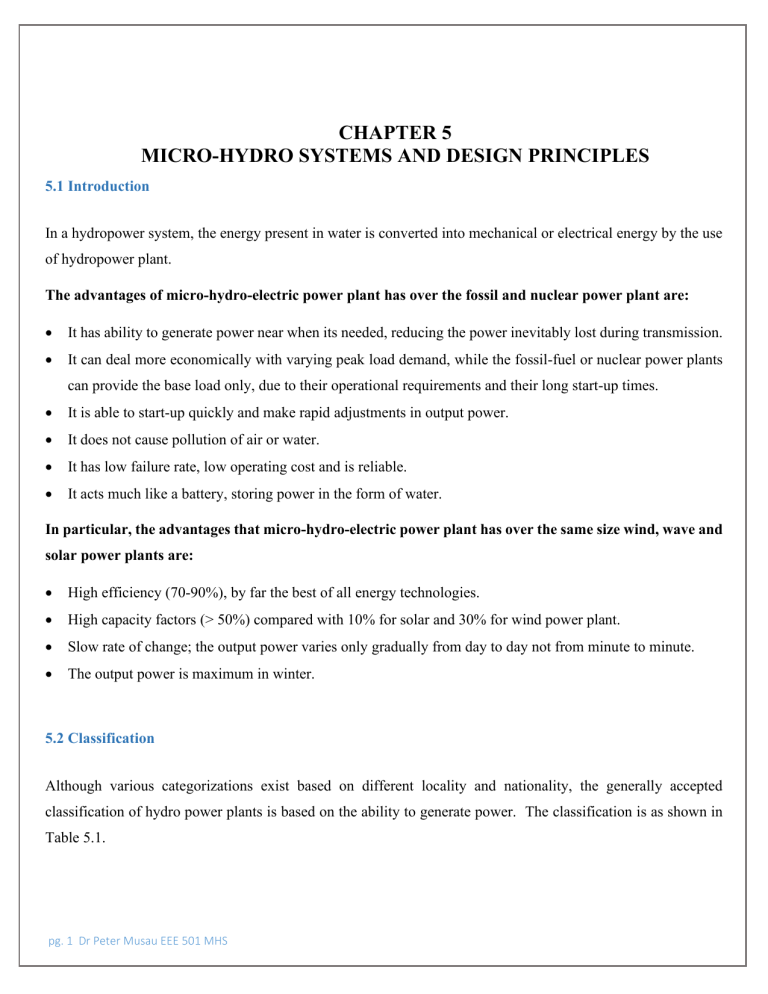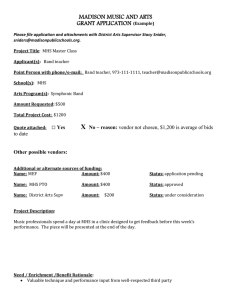
CHAPTER 5 MICRO-HYDRO SYSTEMS AND DESIGN PRINCIPLES 5.1 Introduction In a hydropower system, the energy present in water is converted into mechanical or electrical energy by the use of hydropower plant. The advantages of micro-hydro-electric power plant has over the fossil and nuclear power plant are: • It has ability to generate power near when its needed, reducing the power inevitably lost during transmission. • It can deal more economically with varying peak load demand, while the fossil-fuel or nuclear power plants can provide the base load only, due to their operational requirements and their long start-up times. • It is able to start-up quickly and make rapid adjustments in output power. • It does not cause pollution of air or water. • It has low failure rate, low operating cost and is reliable. • It acts much like a battery, storing power in the form of water. In particular, the advantages that micro-hydro-electric power plant has over the same size wind, wave and solar power plants are: • High efficiency (70-90%), by far the best of all energy technologies. • High capacity factors (> 50%) compared with 10% for solar and 30% for wind power plant. • Slow rate of change; the output power varies only gradually from day to day not from minute to minute. • The output power is maximum in winter. 5.2 Classification Although various categorizations exist based on different locality and nationality, the generally accepted classification of hydro power plants is based on the ability to generate power. The classification is as shown in Table 5.1. pg. 1 Dr Peter Musau EEE 501 MHS Table 5. 1: Classification of Hydro Plants 5.3 Structure of MHS The principal components that are used in the MHS (Micro Hydropower System) could be further classified into civil components, powerhouse components and transmission and distribution networks. All of these components are again elaborated in the following sections. Figure 5.1: Main Components of MHS pg. 2 Dr Peter Musau EEE 501 MHS 5.3.1 Civil Work Components This section describes the components of the typical MHS (Micro Hydropower System) that could be classified as civil works components. The civil components described in this section are those major components such as the intake, headrace canal, de- Sanding basin, spillway, forebay tank, penstock pipes and tailrace. • Intake Intake is the primary means of conveyance of water from the source of water in required quantity towards the waterways of HPP (Hydro Power Project). Intake could be of side intake type or the bottom intake type. Usually, trash racks have to be placed at the intake which acts as the filter to prevent large water born objects to enter the waterway of the MHP (Micro Hydro Project) • Headrace Canal Once the water enters through the intake, the headrace canal conveys the water to the forebay. Sometimes, pipes can also be used in place of the canals. The materials to be used in constructing the canal depends upon the geographical condition of the site and other obvious factors such as the availability of labor and materials. Most usual types of canal are built from combination of cement and mortar, only soil, mixture of stone and mud, mixture of stone masonry with cement and other different types of possible combinations. When pipes are used, they are generally of HDPE (High Density Polythene) types. The length of the headrace canal can be anywhere from few meters to over a kilometer long. The most important thing to consider while constructing head race canal is to make the slope of the canal only slightly elevated because higher slope can lead to higher velocity of water which can then cause erosion in the headrace canal surface. • Settling Basin Specially, in the case of Nepal, rivers generally carry high amount of sediments due to erosion activities in hills and mountains. In order to reduce the sediment density, which has negative impact to other components of the MHS (Micro Hydropower System) de-sanding basins are used to capture sediments by letting the particles settle by reducing the speed of the water and clearing them out before they enter the canal. Therefore, they are usually built at the head of the canal. pg. 3 Dr Peter Musau EEE 501 MHS They are equipped with gate valves for flushing the settled undesirable sediments. De sanding basin is capable of settling particles above 0.2-0.3 mm of size Figure 5.2 shows the typical de-sanding basin. Figure 5. 2 Typical De-Sanding Basin • Spillway Spillways need to be designed to remove the excess water due to floods, in order to minimize the adverse effects to the other components of the MHS (Micro Hydropower System). Spillways are often constructed in de-sanding basin and the forebay, from which the excess water is safely diverted to the water source. Figure 5.3 shows the typical method of construction of the spillway. pg. 4 Dr Peter Musau EEE 501 MHS Figure 5.3 Construction of Spillway • Forebay Tank Forebay tank is basically a pool at the end of headrace canal from which the penstock pipe draws the water. The main purpose of the forebay is to reduce entry of air into the penstock pipe, which in turn could cause cavitation (explosion of the trapped air bublles under high pressure) of both penstock pipes and the turbine. It is also necessary to determine the water level at the forebay because operational head of the microhydro power plant is determined through this factor. A forebay again requires two sets of additional construction. As the water speed is lowered at the forebay, it can cause sedimentation of particles, which requires the construction of spillway as mentioned before. Similarly, installation of trash racks to filter the fine sediments might be required before the water from the forebay gets inside the penstock pipes. Figure 5.4 illustrates a typical forebay tank in MHS. Figure 5.4: Design of a Typical Forebay in MHS • Penstock Pipes Penstock pipes are basically close conduct pipes that helps to convey the water from the forebay tank to the turbine. The materials used in penstock are usually steel, HDPE (High Density Polythene) and increasingly PVC (Poly Vinyl Chloride). It is one of the most important components of the MHS (Micro Hydropower System) because it is at this point that the potential energy of the water is converted into kinetic energy. The velocity of water at the penstock is typically 3m/s and is often located at a slope over 45 degrees. Due to the risk of contraction and expansion of penstock pipes due to fluctuation in seasonal temperature, sliding type of expansion joints are placed between two consecutive pipe lengths. Anchor block, which is basically a mass of concrete fixed into the pg. 5 Dr Peter Musau EEE 501 MHS ground, is used to restrain the penstock from movement in undesirable directions. Figure 5.5 shows the configuration of penstock pipes in typical MHS (Micro Hydropower System). Figure 5.5 Components of the Penstock Assembly. • Tailrace Tailrace is very similar to headrace canal described previously in this section. The only difference with that of the headrace canal is that it is situated at the end of the civil components and is used to convey the water back to the source after use in the micro hydro plant. 5.3.2 Powerhouse Component It is at this stage that the conversion of mechanical energy of water into electrical energy takes place. Basically, powerhouse consists of electro-mechanical equipment such as turbines, generator and drive systems which will be explored further in the following sections. • Turbine pg. 6 Dr Peter Musau EEE 501 MHS In a MHS (Micro Hydropower System) hydraulic turbine is the primary component which converts the energy of the flowing water into mechanical energy through the rotation of the runner. The choice of particular turbine depends upon technical parameters such as design head and discharge at which the turbine is to operate as well as other practical considerations such as the availability and cost of maintenance personnel. The optimum speed of the turbine is the particular speed of its rotor at which the turbine performs its best. The turbine needs to operate at this optimum speed in order to get maximum possible output at all loading conditions. Based on its functionality, turbines have been generally differentiated into two groups: impulse turbine and reaction turbine. Under impulse turbine; pelton, turgo and cross-flow turbine are included. They are different from the reaction turbine in that their rotors are not submerged in the water but are allowed to rotate freely in the atmospheric pressure. The bucket that is mounted on the periphery of the runner is affected by the impulse force of the high velocity water which rotates the runner and shaft of the turbine. When the water passes through its free jet type nozzle, the pressure energy in the water is converted into kinetic energy. Reaction turbine are different from impulse turbine in that the turbine’s rotor is submerged in water and the water acting on the wheel is greater than the atmospheric pressure. It derives its name partly because it runs by the reaction force of the exiting water. At the outlet, a draft tube is fitted in the turbine. The runner utilizes both the potential as well as kinetic energy of the water. • Generators Although this study is not overly concerned with the selection, and uses of generators in the MHS (Micro Hydropower System) it is, however, relevant to describe the basic types of generators and how they are integrated in the MHS (Micro Hydropower System). There are basically two types of generators in use for hydroelectricity generation; either synchronous or induction generators. Synchronous generators are the primary types of generators which are used extensively in large scale power generation. When the power output levels are generally low (less than10 MW), induction generators are extensively used. Induction generators are also the preferred type of generators in MHP (Micro Hydro Project) because they can operate at variable speeds with constant frequency, are available cheaply and requires less maintenance than the synchronous generators. Both of these generators have the possibility to be used connected to the grid or just standalone operation. • Drive Systems The main purpose of the drive systems is to transmit the power from turbine to the generators at a stable voltage and frequency at a required direction and required speed. Like any normal drive systems, in a MHS (Micro Hydropower System) also, drive systems comprise of generator shaft, turbine shaft, bearings, couplings, gearboxes and belts and pulleys. The different types of drive systems common in MHS (Micro Hydropower System) are direct drive, “V” or wedge belts and pulleys, timing belt and sprocket pulley and gearbox drive systems. A direct drive system is one in which the turbine shaft is connected directly to the generator shaft. In pg. 7 Dr Peter Musau EEE 501 MHS contrast, “V” or wedge belts and pulleys are the most commonly used type of drive systems in MHS (Micro Hydropower System). However, in very small systems (less than 3 kW) where efficiency is critical, timing belt and sprocket pulley are commonly used. Gearboxes are suitable in large machine where drive belts are not efficient. Due to high maintenance and alignment costs of gearboxes, they are less frequently used in MHS (Micro Hydropower System). Figure 5.6 shows a typical direct coupled drive system. Figure 5.6 Direct Coupled Drive System • Electrical Load Controllers All MHS (Micro Hydropower System) will have to have switchgear in order to separate the power flow when necessary and also to control the electrical power flow. There are several different kinds of switches used in an MHS such as isolators which are manually operated, switch fuses which additionally can provide fuse for current limiting, MCCB (Molded Case Circuit Breakers) which are used for protection from over current or short circuits and so on. The choice of electronic load controller is largely dependent upon the type of generator installed in MHS. For instance, when the induction generator is used in the MHS it is necessary to install Induction Generator Controllers (IGC). Additionally, transmission network are also a major component of the MHS. If the output is fed into some other grid system; however, detailed description of electrical load controller is beyond the scope of this thesis as it is concerned primarily with the design of the civil works components. pg. 8 Dr Peter Musau EEE 501 MHS 5.4 The Energy Conversion System Potential Energy in the Water is given by 𝑃. 𝐸 = 𝑚𝑔𝐻 (𝑖) Where m is the mass of water (kg), g is gravitational acceleration and H is the water head Now 𝑚 = 𝜌𝜗 (𝑖𝑖) Where 𝜌 𝑖𝑠 𝑑𝑒𝑛𝑠𝑖𝑡𝑦 𝑜𝑓 𝑤𝑎𝑡𝑒𝑟 𝑖𝑛 𝐾𝑔/𝑚3 and 𝜗 𝑖𝑠 𝑡ℎ𝑒 𝑣𝑜𝑙𝑚𝑒 𝑜𝑓 𝑤𝑎𝑡𝑒𝑟 (𝑚3 ). Hence 𝑃. 𝐸 = 𝜌𝜗 𝑔𝐻 (𝑖𝑖𝑖) The energy developed by the water turbine (𝐸𝑇 ) is given by 𝐸𝑇 = 𝜂 𝑃. 𝐸 = 𝜂 𝜌𝜗 𝑔𝐻 (𝑖𝑣) Where 𝜂 is the turbine efficiency The energy developed by the water turbine (𝑃𝑇 ) is given by 𝑃𝑇 = 𝐸𝑇 𝑡 = 𝜂 𝜌𝜗 𝑔𝐻 𝑡 (𝑣) By definition, the flow rate of water (Q) is given by 𝑄 = 𝜗⁄𝑡 (𝑚3 ⁄𝑠) (𝑣𝑖) Thus 𝑃𝑇 = 𝐸𝑇 𝑡 = 𝑄 𝜂 𝜌 𝑔𝐻 (𝑣𝑖𝑖) 5.5 MHS Design Principles a) Flow Duration Curve (FDC) The choice of turbine type, size and speed is based on the net head and maximum water flow rate, which must be determined by the river or stream where the turbine shall be installed. Because of micro-hydro-electric power plants are normally built as run of the river plants, the maximum water flow capacity of the turbine must be determined by mean of the flow duration curve for the river or stream. A way for organizing discharge data is by plotting a flow duration curve, that shows for a particular point on a river the proportion of time during which the discharge there equal or exceeds certain values. It can be obtained from the hydro-graph by organizing the data pg. 9 Dr Peter Musau EEE 501 MHS by magnitude instead of chronologically. The mean annual flow gives an idea of a stream's power potential. FDC can be produced for particular periods of time as well as for particular years. 5.6 Design Case A micro hydro system (MHS) has the design features shown in the Table below. From first principles, design the MHS by providing Civil, Mechanical and Electrical Details (30 marks) 5.7 Design Questions pg. 10 Dr Peter Musau EEE 501 MHS 1) Determine the firm capacity and the yearly gross output at a site of MHS where it has been estimated that the minimum flow rate of approximately 94cubic meter per second will be available at a hydraulic project with a head of 50 meters. 2) A MHS has to operate with a mean head of 30 meters and is supplied from a reservoir lake at the rate of 6.93 m3 per second. Calculate the power generated in kW. Assume density of water 1000 𝑘𝑔/𝑚3 , load factor of the station is 80%, mechanical efficiency of water turbine is 90%, and efficiency of generator is 90%. Neglect head loss in pipes, penstocks etc. 3) A MHP has s reservoir area of 4.4 square kilometers and a capacity of 5𝑥106 cubic metres. The effective head of the water is 100 metres. The penstock, turbine and generation efficiencies are respectively 95%, 90% and 85%. Determine the (i) Total electrical energy that can be generated from the MHPP (ii) Fall in reservoir level if a load of 15MW has been supplied for 3Hours 4) A MHS operates under a mean head of 30 meters. The reservoir employed has a catchments area of 4𝑥 108 𝑚2 . The average rainfall in this area is 125 cm per annum. Determine the capacity of the station for which it should be designed. Assume that 30% of the rainfall is lost due to evaporation etc., 5% of the head is lost in penstock, turbine efficiency is 85%, alternator efficiency is 85% and the load factor is 50%. pg. 11 Dr Peter Musau EEE 501 MHS


